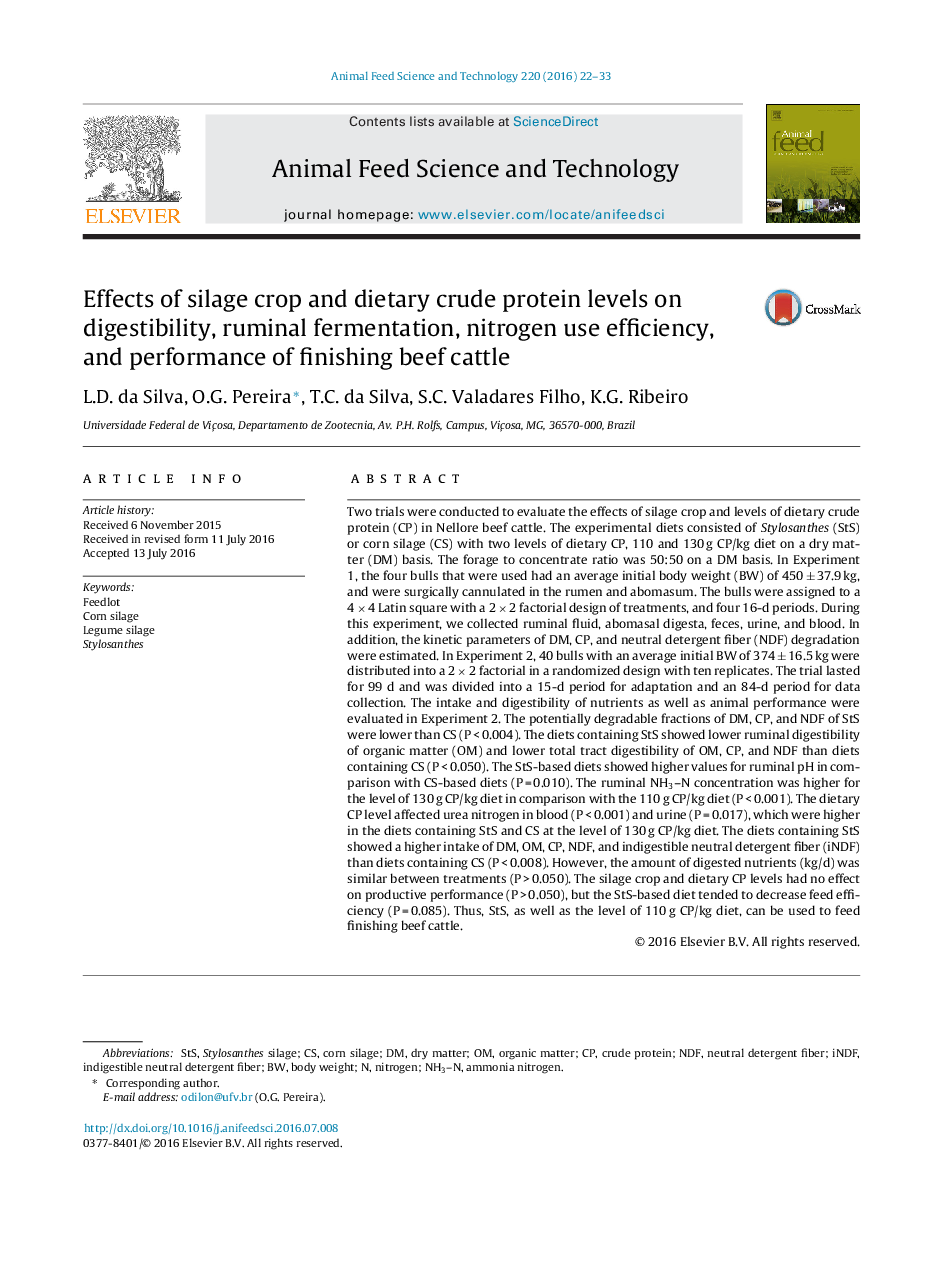| کد مقاله | کد نشریه | سال انتشار | مقاله انگلیسی | نسخه تمام متن |
|---|---|---|---|---|
| 2419234 | 1552365 | 2016 | 12 صفحه PDF | دانلود رایگان |
• Diets containing Stylosanthes silage showed lower digestibility but higher intake than diets containing corn silage.
• Diets containing Stylosanthes silage as well as the level of 110 g CP/kg diet did not compromise the feedlot performance of Nellore.
• Stylosanthes silage-based diets tended to decrease feed efficiency in comparison to corn silage-based diets.
Two trials were conducted to evaluate the effects of silage crop and levels of dietary crude protein (CP) in Nellore beef cattle. The experimental diets consisted of Stylosanthes (StS) or corn silage (CS) with two levels of dietary CP, 110 and 130 g CP/kg diet on a dry matter (DM) basis. The forage to concentrate ratio was 50:50 on a DM basis. In Experiment 1, the four bulls that were used had an average initial body weight (BW) of 450 ± 37.9 kg, and were surgically cannulated in the rumen and abomasum. The bulls were assigned to a 4 × 4 Latin square with a 2 × 2 factorial design of treatments, and four 16-d periods. During this experiment, we collected ruminal fluid, abomasal digesta, feces, urine, and blood. In addition, the kinetic parameters of DM, CP, and neutral detergent fiber (NDF) degradation were estimated. In Experiment 2, 40 bulls with an average initial BW of 374 ± 16.5 kg were distributed into a 2 × 2 factorial in a randomized design with ten replicates. The trial lasted for 99 d and was divided into a 15-d period for adaptation and an 84-d period for data collection. The intake and digestibility of nutrients as well as animal performance were evaluated in Experiment 2. The potentially degradable fractions of DM, CP, and NDF of StS were lower than CS (P < 0.004). The diets containing StS showed lower ruminal digestibility of organic matter (OM) and lower total tract digestibility of OM, CP, and NDF than diets containing CS (P < 0.050). The StS-based diets showed higher values for ruminal pH in comparison with CS-based diets (P = 0.010). The ruminal NH3–N concentration was higher for the level of 130 g CP/kg diet in comparison with the 110 g CP/kg diet (P < 0.001). The dietary CP level affected urea nitrogen in blood (P < 0.001) and urine (P = 0.017), which were higher in the diets containing StS and CS at the level of 130 g CP/kg diet. The diets containing StS showed a higher intake of DM, OM, CP, NDF, and indigestible neutral detergent fiber (iNDF) than diets containing CS (P < 0.008). However, the amount of digested nutrients (kg/d) was similar between treatments (P > 0.050). The silage crop and dietary CP levels had no effect on productive performance (P > 0.050), but the StS-based diet tended to decrease feed efficiency (P = 0.085). Thus, StS, as well as the level of 110 g CP/kg diet, can be used to feed finishing beef cattle.
Journal: Animal Feed Science and Technology - Volume 220, October 2016, Pages 22–33
